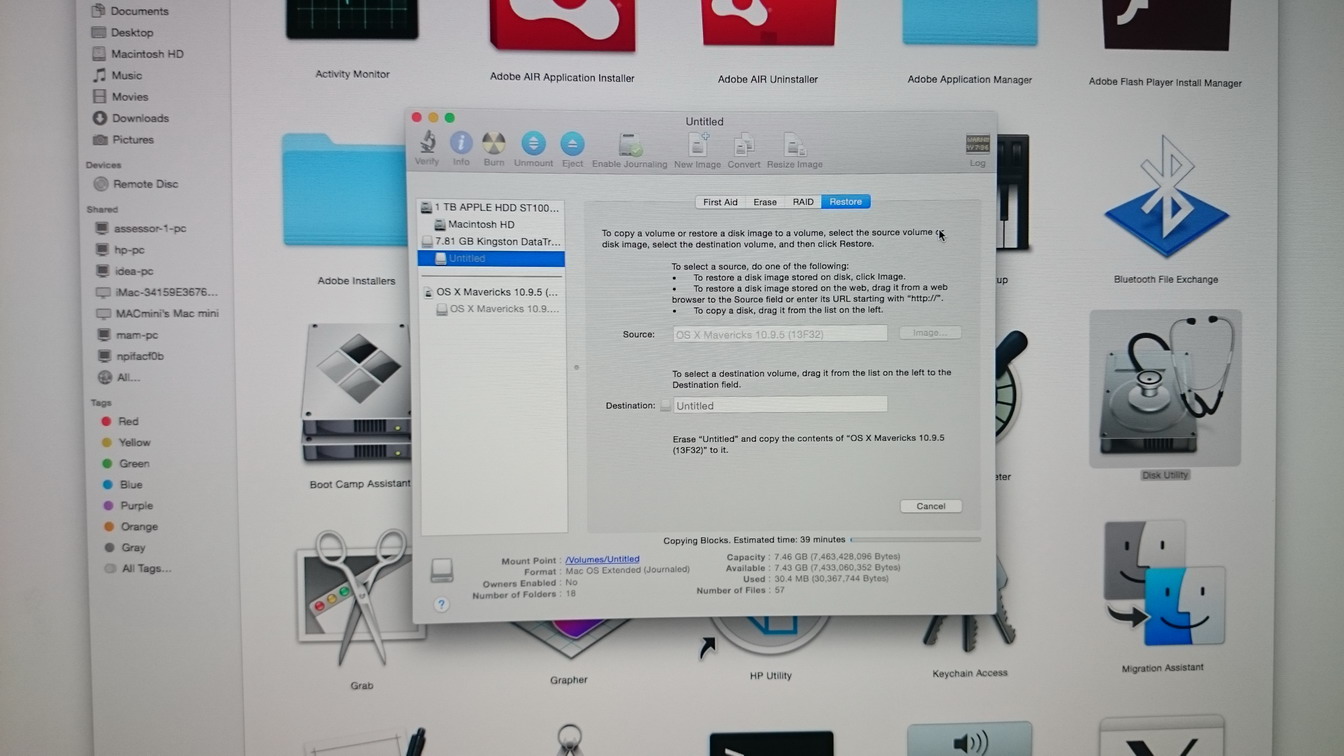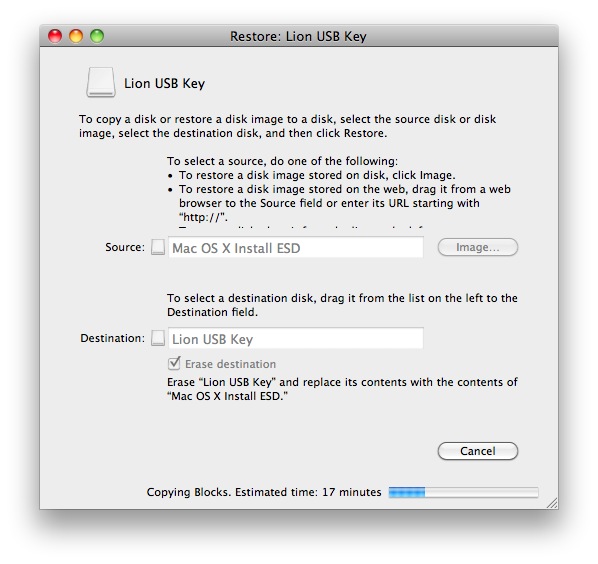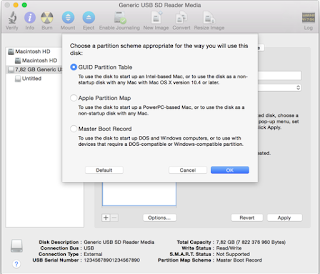Bootable USB Installers for OS X Mavericks, Yosemite, El Capitan, and Sierra. First, review this introductory article: Create a bootable installer for macOS. Second, see this How To outline for creating a bootable El Capitan installer. Simply replace the Terminal command with the one from the preceding article by copying it into the Terminal. Feb 19, 2018 Scan the DMG for restore Lock the DMG in Finder (Command+I, check Locked) Find and insert the USB you intend to use into the Mac If the Mac says 'cannot read drive', ignore and initialize it anyway. Make A Bootable Mac DMG USB With TransMac!Thanks For Watching!As Always if you liked this video, don't forget to Subscribe!Get Cheap Games at G2A Link Below.
Easy enough right? Ok so here’s how you create a bootable Snow Leopard installation drive out of your external firewire or USB hard disk. Install Mac OS X 10.6 Snow Leopard from an external Firewire or USB drive. Launch Disk Utility. Select the External Firewire/USB device that you want to use as the boot drive for the upgrade. In the Disk Utility app on your Mac, select the volume that you want to restore in the sidebar, then click the Restore button. This is the volume that is erased and becomes the exact copy. Click the Restore pop-up menu, then choose the volume you want to copy.
- Products ▼
- For Windows
- Android Manager for Win
- Android Data Recovery
- Phone Transfer for Win
- Android Root Pro
- For Mac
- Android Manager for Mac
- Android Data Recovery Mac
- Phone Transfer for Mac
- More >>>
A DMG file is Apple's equivalent of an ISO installation file or disk image. It usually contains all the information required to install a program on a Mac computer running Mac OS X or macOS. It is also a container to hold macOS installation image. If you want to create a bootable macOS bootable disk, the first step is to burn DMG to USB or DVD.
However, native support for DMG files is only available on Apple's desktop operating system. For Windows or Linux, you will need to use different methods. For example, if you want to burn a DMG file to USB on a Mac, it's as easy as using the built-in Disk Utility tool. On Linux and Windows, you obviously have to use other ways. This article explains how to burn a DMG file to a USB flash drive on a Mac, a Windows computer and a machine running Linux.
Method 1: How to Burn DMG to USB on macOS or Mac OS X
If you have a Mac, then Disk Utility will help you create your bootable USB drive. Since this is a native application, no downloads are required. The built-in tool will be able to directly burn the DMG file to a disk or drive. You simply have to follow the process as described below:
Step 1: Open Disk Utility by going to Applications >> Utilities and clicking on the tool.
Step 2: You should be able to see all the drive names in the left-side panel. Now open a Finder window and drag your DMG file into Disk Utility. Drop it in the blank area below the drive names on the left panel.
Step 3: You can now insert your USB drive and wait for it to appear in the drives list. Next, click on your mounted DMG file on the left panel and click on ‘Burn' in the top toolbar. When you see the ‘Burn Disk In:' message, click on the USB drive.
The DMG file will now be burned to the USB drive, and you can use it to do program installations. Disk Utility has a good burn success rate, so hopefully you won't have to repeat the process to get it right.
Method 2: How to Burn DMG to USB in Windows 10 (Bootable)
Since Windows doesn't natively support DMG files, you will need to first download and install a utility that can handle such disk images. The best software for the job is DMG Editor, a Windows-based desktop solution for authoring Apple's disk image files in a non-Mac environment.
DMG Editor requires no technical expertise to use. The clean interface only shows the user the necessary functions, and all the heavy lifting is done at the back end. One of the unique features of this increasingly popular software is the amount of beta testing it has gone through. Extensive and gruelling tests with different storage media brands and Windows versions have made this one of the most reliable DMG utilities for Windows. With one of the industry's highest burn success rates, it's no wonder that DMG Editor is emerging as the leader in its class.
Step 1 Install DMG Editor
Download DMG Editor to your Windows PC and install the program by following the setup instructions in the wizard.
Step 2 Load DMG File into DMG Editor
Mac Restore Dmg To Usb Pc Camera
After launching the program, you'll see various options on the home page. Click on 'Burn' to kick off the process. Now click on 'Browse' to add the file to the program, and insert a USB flash drive.
Step 3 Start Burning DMG to USB
The drive will be automatically detected by the software, so all that's left is to click on 'Burn' and wait for your drive to get ready.
Step 4 Install macOS from USB Drive
When the burning process is completed successfully, you will receive a message like the following screenshot. It means the job is done without any error. Now insert the USB on your Mac and press Power + Option key to open Startup Manager. From there, you can start macOS installation.
You won't be able to find other alternatives that can do the job in such an easy way. For Windows users, DMG Editor is the best tool to create bootable macOS USB or DVD.
Method 3: How to Burn a DMG File to USB in Linux
The process of burning a DMG to USB in Linux is a little more complicated since it requires converting the file to an ISO before burning it to a drive. It also requires command line executions, but if you own a Linux machine you may already be familiar with command line work. Please note that in order for the USB drive to be bootable, the original DMG must have boot information. In here, we take Ubuntu Linux as an example.
Step 1: Download and install dmg2img by using the following command: sudo apt-get install dmg2img
Step 2: Convert the DMG to IMG with the following command: dmg2img sample.dmg
Step 3: Change the filename of the resulting .img file to .iso. Remember, this is still an IMG file, but it will have a .iso extension. Use the command below to do this: mv sample.img sample.iso
Step 4: Insert the USB drive, but make sure it is not mounted. If it is, you can unmount it with the following command: sudo umount /media/
Make sure you know the file path to the mounted USB drive. Although external drives are generally mounted in /media in Linux, it could be in a different location. To check, you can use this command: lsblk

This command reads the sysfs file system and shows you information about block devices. Your drive can usually be identified by the size, but make sure you use the correct disk name, not the partitions within the disk.
Step 5: You can now burn the DMG to the USB drive with the following command:


sudo dd bs=4M if=sample.iso of=/dev/sdX %% sync
Dmg To Usb Bootable
If the original DMG file was bootable, then this .img version on your USB will also be bootable. The process looks a bit complicated, but it should work as long as you follow the steps described above.
The Bottom Line:
As we can see, burning DMG to USB on Mac is the easiest solution as you don't need to install any other tools or type command to complete the task, which could be annoying for some users. How about the Mac was broken and you want to create a bootable macOS disk to repair the computer? That depends what kind of computer you get at hand. Just follow the steps listed above according to the computer model.
Related Articles
- Windows 10 Password Crack | Remove Windows Admin Password | Change Windows Password | Bootable Windows USB | ISO to USB Tool | Create Windows Reset Disk | Burn ISO to CD | Create Windows Reset Disk | More>>>
Summary: In this blog, we will share two methods to create a disk image-the first one using macOS Catalina’s Disk Utility and the second using a Mac data recovery application.
Read on to know the steps and benefits of these methods. Also, make sure you avail the free trial version of Stellar Data Recovery application.
Disk image of an external or an inbuilt Mac storage drive is immensely helpful in recovering files in case the source drive fails or dies. You can create a disk image of your APFS or HFS drive on a larger storage medium and access it at a later point of time.
Create a Disk Image Using Disk Utility on macOS Catalina
macOS Catalina’s inbuilt Disk Utility provides an option to select a mounted storage drive be it internal or external SSD/HDD and create a disk image (.DMG) file to a location other than the source disk. The systematic steps to create a disk image of a drive using Disk Utility are as follows:
- Open DiskUtility and select the storage drive from the sidebar
- Go to File > New Image > Image from “DriveName”
- Give a name to your disk image file and provide a destination to save the file
- Click the Format popup menu, then choose your required option
- If you want to limit the access of this disk image file, then click the Encryption popup menu to set a password for its access
- Click Save to continue the imaging process
- Click Done once the imaging process is over
Disk Utility mounts the image file’s disk icon on the desktop and sidebar of Finder. You can use the mounted image file to open its content.
Create a Disk Image Using a Mac Data Recovery Utility on macOS Catalina
The third-party data recovery utility, Stellar Data Recovery Professional for Mac also allows you to create a disk image (.DMG) file of the inbuilt Mac storage drive/volume or an external storage device. The logical steps to create a disk image of a drive using the utility are as follows:
Step 1)Download and install Stellar Data Recovery Professional on your Mac with installed macOS Catalina (or later macOS/OSX)
Step 2) Launch the software and select RecoverData from the main interface
Step 3) Click the ‘2nd‘ icon present at the top of the interface and select CreateImage
Step 4) From the “CreateImage” screen, select a drive or a volume to create an image file
Step 5) If you wish to create an image of the entire selected storage location, click Next
Step 6) If you wish to select the range to create an image, click the AdvancedSettings
- From the “SelectRangetoCreateImage” screen, drag the sliders to define the starting and ending sectors of the image file
- Click Close and then click Next
Step 7) In the “CreatingMediaImagetoSave” dialog box, locate the destination where you wish to save the image file
Mac Restore Dmg To Usb Mode
Step 8) In the “SaveAs” text box, type the disk image name and then click Save
This completes the disk imaging process using the software. Unlike Disk Utility, macOS Catalina does not mount this image file for you to access its data. Nevertheless, you can keep this newly created disk image as a backup and use it to recover data at the time of data loss.
Recover Data from a Disk Image Using the Software
The methodical steps to use the .DMG file for data recovery are as follows:
Step 1) Launch the software and select Recover Data from the main interface
Step 2) Click the ‘2nd’ icon present at the top of the interface and select Load Image
Step 3) From the “Load Image” screen, select the .DMG file or else click Add to add the image file
Step 4) Click Scan to start the recovery process
Step 5) Once the scan is over, preview and select the required files then click Recover
Step 6) Specify the save location and click Save. You can find the recovered data in the saved location. Watch the below video for the process.
Conclusion
We hope the blog helped you in understanding the practical details of how you can create a disk image file of a storage drive on macOS Catalina. By implementing Disk Utility, you can generate a disk image file and can open the automatically mounted image file from the saved location. On the contrary, by using Stellar Data Recovery Professional for Mac, you create a disk image file and use it to scan and recover lost, deleted, or inaccessible files.
Unlike Disk Utility, the software allows you to select the specific region of the drive for image creation. We recommend this method to recover files from a storage drive that is too big in size. For instance, if your storage drive has the data storage capacity of say 8 TB, then you need to recover data in portions. Free download the software to create an image, scan, and preview files. Register the software to save the recoverable files.
